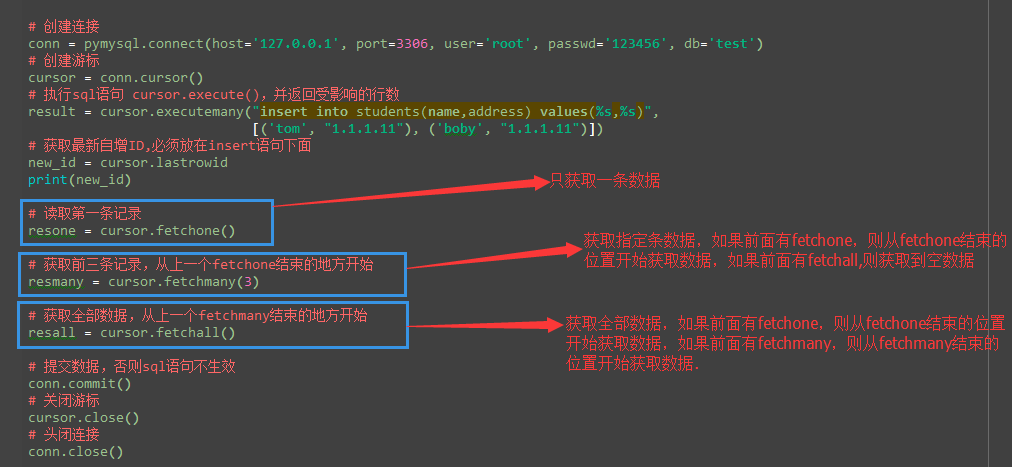mysql操作
请自行安装mysql服务及mysql客户端,官网地址 http://dev.mysql.com/downloads/mysql/
mysql详细安装,操作请参考 http://www.cnblogs.com/wupeiqi/articles/5699254.html
mysql的一些简单语句
SHOW DATABASES; #查看当前数据库的的库名 USE test; #使用test库 SHOW TABLES; #查看当前库名中的表 CREATE DATABASE students; #创建一个数据库名字为students FLUSH PRIVILEGES; #刷新系统权限表

# 创建用户 create user '用户名'@'IP地址' identified by '密码'; # 删除用户 drop user '用户名'@'IP地址'; # 修改用户 rename user '用户名'@'IP地址'; to '新用户名'@'IP地址';; # 修改密码 set password for '用户名'@'IP地址' = Password('新密码') # 授权管理: show grants for '用户'@'IP地址' -- 查看权限 grant 权限 on 数据库.表 to '用户'@'IP地址' -- 授权 revoke 权限 on 数据库.表 from '用户'@'IP地址' -- 取消权限 # 创建表 create table 表名( 列名 类型 是否可以为空, 列名 类型 是否可以为空 ) # 删除表 drop table 表名 # 清空表 delete from 表名 truncate table 表名 # 修改表 添加列:alter table 表名 add 列名 类型 删除列:alter table 表名 drop column 列名 修改列: alter table 表名 modify column 列名 类型; -- 类型 alter table 表名 change 原列名 新列名 类型; -- 列名,类型 添加主键: alter table 表名 add primary key(列名); 删除主键: alter table 表名 drop primary key; alter table 表名 modify 列名 int, drop primary key; 添加外键:alter table 从表 add constraint 外键名称(形如:FK_从表_主表) foreign key 从表(外键字段) references 主表(主键字段); 删除外键:alter table 表名 drop foreign key 外键名称 修改默认值:ALTER TABLE testalter_tbl ALTER i SET DEFAULT 1000; 删除默认值:ALTER TABLE testalter_tbl ALTER i DROP DEFAULT;
mysql API pymsql
pymsql是Python中操作MySQL的模块,其使用方法和MySQLdb几乎相同。
一、下载安装:
|
1
|
pip3 install pymysql |
二、基本使用
1、创建连接,并执行SQL,简单实例
#!/bin/bin/env python # -*-coding:utf-8 -*- # Author : rain import pymysql # 创建连接 conn = pymysql.connect(host='127.0.0.1', port='3306', user='root', passwd='123456', db='test') # 创建游标 cursor = conn.cursor() # 执行sql语句插入一行数据,并返回受影响的行数 res = cursor.execute("insert into students (name, adress) values ('rain', 'china') ") # 提交数据,否则sql语句不生效 conn.commit() # 关闭游标 cursor.close() # 头闭连接 conn.close()

#!/bin/bin/env python # -*-coding:utf-8 -*- # Author : rain import pymysql # ''' # 创建连接 conn = pymysql.connect(host='127.0.0.1', port='3306', user='root', passwd='123456', db='test') # 创建游标 cursor = conn.cursor() # 删除表 reste = cursor.execute('delete from hello') # 创建表 rest = cursor.execute("create table hello(id int AUTO_INCREMENT primary key not null,name CHAR(24) not null)") # 执行sql语句插入一行数据,并返回受影响的行数 res = cursor.execute("insert into students (name, adress) values ('rain', 'china') ") # 一次性插入多条数据,并返回受影响的行数 res1 = cursor.executemany("insert into students(name, adress))values(%s, %s)", [('yxy', 'china'), ('window', 'UK')]) # 更新一条数据 res2 = cursor.execute("update students set name='windows' where address ='UK'") # 删除一条数据 res3 = cursor.execute("delete from students where id=1 and name='UK'") # 删除整张表 res4 = cursor.execute("delete from students") # 提交数据,否则sql语句不生效 conn.commit() # 关闭游标 cursor.close() # 头闭连接 conn.close() # 获取最新自增ID new_id = cursor.lastrowid
2、获取查询数据
# 创建连接 conn = pymysql.connect(host='127.0.0.1', port=3306, user='root', passwd='123456', db='test') # 创建游标 cursor = conn.cursor() # 执行sql语句 cursor.execute(),并返回受影响的行数 restin = cursor.execute("insert into students ( name, address) values('hi', 'china')") # 执行查询语句 rest = cursor.execute('select * from test.students') print(rest) # 获取最新自增ID,必须放在insert语句下面 new_id = cursor.lastrowid print(new_id) # 读取第一条记录 queryone = cursor.fetchone() # (1, 'yxy', 'china') # 获取前三条记录,从上一个fetchone结束的地方开始 querymany = cursor.fetchmany(4) # ((2, 'rain', 'UK'), (3, 'windows', 'china'), (4, 'pay', 'Uk'), (5, 'pay', 'Uk')) # 获取全部数据,从上一个fetchmany结束的地方开始 queryall = cursor.fetchall() # ((6, 'hello', 'china'), (7, 'hello', 'china'), (8, 'hello', 'china')) print(queryone) print(querymany) print(queryall) # 提交数据,否则sql语句不生效 conn.commit() # 关闭游标 cursor.close() # 头闭连接 conn.close()
注:在fetch数据时按照顺序进行,可以使用cursor.scroll(num,mode)来移动游标位置,如:
- cursor.scroll(1,mode='relative') # 相对当前位置移动
- cursor.scroll(2,mode='absolute') # 相对绝对位置移动

3、fetch数据类型
关于默认获取的数据是元祖类型,如果想要或者字典类型的数据,即:
#!/usr/bin/env python # -*- coding:utf-8 -*- import pymysql conn = pymysql.connect(host='127.0.0.1',user='root',passwd='123456',db='test') # 将游标设置成字典类型 cur = conn.cursor(cursor=pymysql.cursors.DictCursor) a = cur.execute('select * from students') print(a) result = cur.fetchmany(3) # ({'name': 'yxy', 'id': 1, 'address': 'china'}, # {'name': 'rain', 'id': 2, 'address': 'UK'}, # {'name': 'windows', 'id': 3, 'address': 'china'}) print(result) conn.commit() cur.close() conn.close()
如有另外见解,稍后补充。。。
